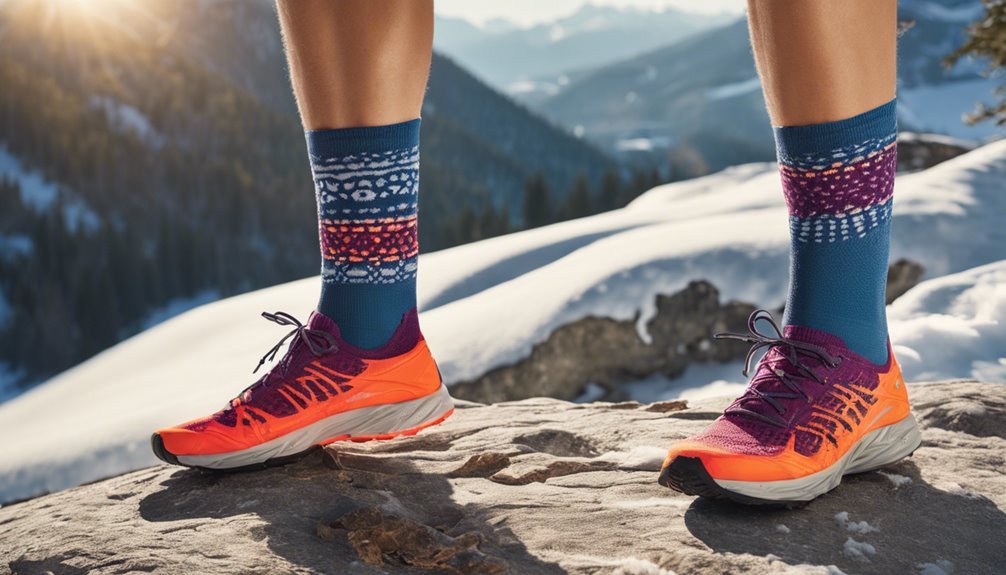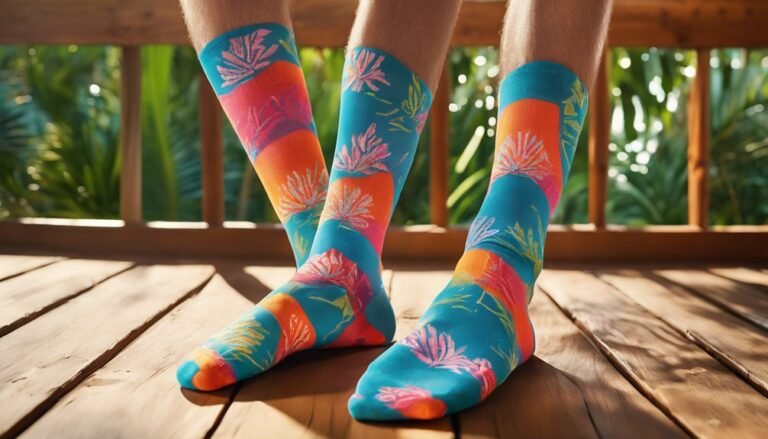Summer Running Socks vs. Winter Running Socks: Which Keeps Feet Comfortable?
When it comes to comfort, summer running socks focus on moisture-wicking properties and lightweight materials to keep your feet cool. In contrast, winter running socks prioritize insulation and thermal regulation, ensuring warmth in colder conditions. Each season offers distinct benefits, so choose based on the climate and your running style. Proper fit, sock height, and cushioning also play vital roles in maintaining comfort. To discover more about enhancing your running experience, you'll want to check out the details ahead.
The Importance of Choosing the Right Running Socks
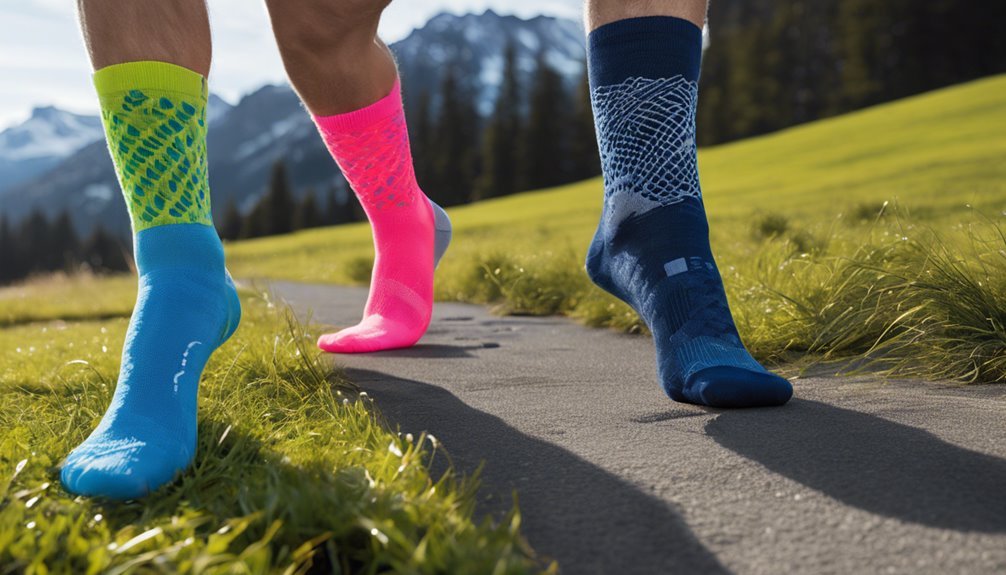
When it comes to running, the right pair of socks can make all the difference in your performance and comfort. Choosing socks that enhance sock performance can help reduce blisters, wick moisture, and provide the support your feet need. Seasonal comfort is vital too; what works in summer may not suit winter conditions. In warmer months, lightweight, breathable fabrics keep your feet cool, while thicker, insulating materials are necessary for colder runs. Your socks should fit snugly without being restrictive, allowing your feet to move freely. Investing in the right running socks tailored for the season can elevate your running experience, enabling you to focus on your goals and enjoy the freedom of the open road. Don't underestimate their impact!
Features of Summer Running Socks
Choosing the right summer running socks can greatly enhance your running experience. Summer sock benefits include moisture-wicking properties that keep your feet dry and comfortable, reducing the risk of blisters. Look for lightweight, breathable materials like mesh and nylon that allow airflow, helping to regulate temperature during those hot runs.
Running sock styles vary, from ankle to crew lengths, so you can choose what feels best for you. Compression features are also popular, as they support blood circulation and can reduce fatigue. Additionally, consider socks with seamless designs to minimize friction. Ultimately, the right summer running socks provide not just comfort but also the freedom to run your best in the heat, making every mile enjoyable.
Features of Winter Running Socks
Although winter running presents unique challenges, the right pair of winter running socks can make all the difference in maintaining warmth and comfort. To guarantee your feet stay cozy and protected, look for these key features:
- Thermal Regulation: Effective winter socks should manage moisture while providing insulation, preventing your feet from getting too cold or sweaty.
- Sock Durability: High-quality materials enhance longevity, so your socks can withstand the rigors of winter running without thinning or tearing.
- Comfort Fit: A snug, yet flexible fit helps reduce friction and blisters, ensuring your runs remain enjoyable despite the chill.
Choosing the right winter running socks can enhance your experience, allowing you to embrace the freedom of running in all conditions.
Materials Used in Summer Running Socks
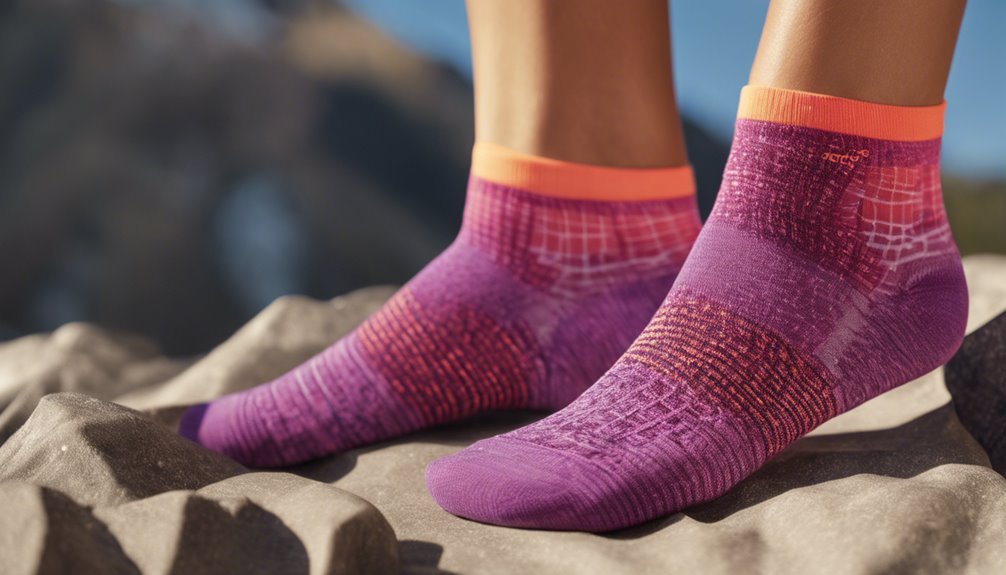
To guarantee your feet stay cool and dry during summer runs, it is crucial to pay attention to the materials used in running socks. You'll want to look for summer sock technologies that prioritize breathability and moisture-wicking capabilities. Lightweight materials like nylon, polyester, and spandex are commonly used, ensuring that your socks won't weigh you down while providing ample ventilation. These fabrics dry quickly, reducing the risk of blisters and discomfort from sweat build-up. Additionally, some brands incorporate mesh panels to enhance airflow, further promoting a cool feel. By choosing socks made from these advanced materials, you can enjoy your runs without worrying about overheating or soggy feet, allowing you the freedom to focus on your performance.
Materials Used in Winter Running Socks
When choosing winter running socks, you'll want to take into account insulation properties, moisture-wicking capabilities, and cushioning support. These materials work together to keep your feet warm, dry, and comfortable during those chilly runs. Understanding how each component contributes to your overall experience can help you make the best choice for your winter workouts.
Insulation Properties
Winter running socks are designed with specific insulation properties that make them essential for cold-weather workouts. Their insulation efficiency plays a vital role in keeping your feet warm while allowing for breathability. Here are three key materials often used:
- Merino Wool: Offers excellent thermal regulation and moisture management, keeping your feet warm and dry.
- Synthetic Blends: These materials often enhance durability and wick moisture away, ensuring insulation isn't compromised during intense runs.
- Thinsulate: Known for its lightweight warmth, it provides an efficient barrier against the cold without bulk.
Moisture Wicking
How essential is moisture management in winter running socks? It's vital for keeping your feet dry and comfortable during cold-weather runs. Winter socks often incorporate synthetic materials like polyester and nylon, which excel in moisture-wicking capabilities. These materials actively pull sweat away from your skin, minimizing moisture retention and preventing discomfort. In addition, look for socks designed with enhanced sock elasticity; this guarantees a snug fit that supports moisture management without restricting movement. A good balance of moisture wicking and elasticity helps maintain thermal regulation, allowing you to focus on enjoying your run without the distraction of wet, cold feet. Selecting the right winter running socks can greatly elevate your overall running experience, empowering you to embrace the chill.
Cushioning and Support
While you might prioritize moisture management, cushioning and support also play essential roles in winter running socks. The right materials can greatly enhance your comfort and performance in cold conditions. Here are three key aspects to evaluate:
- Cushioning Technology: Look for socks incorporating advanced cushioning technology, like gel or foam inserts, to absorb impact and reduce fatigue during long runs.
- Support Systems: Opt for socks that feature targeted support systems, such as arch support and ankle compression, to stabilize your foot and prevent injuries.
- Material Composition: Choose socks made from a blend of merino wool and synthetic fibers, which provide warmth while maintaining breathability and cushioning.
Investing in the right winter running socks will keep your feet comfortable and empowered on every run.
Breathability vs. Insulation: What You Need
When choosing running socks, what matters more: breathability or insulation? If you're running in the heat, breathable fabrics are essential. They allow air to circulate, keeping your feet cool and preventing moisture buildup. On the other hand, in colder conditions, insulation becomes key. You want socks that provide thermal regulation, trapping warmth without suffocating your feet. The ideal sock balances both features, but your specific needs depend on the weather. For summer runs, opt for lightweight, breathable options that wick sweat away. In winter, choose thicker socks with insulating properties to maintain comfort. Ultimately, knowing when to prioritize breathability or insulation will enhance your running experience, allowing you to focus on what you love: the freedom of the run.
Moisture Management Techniques
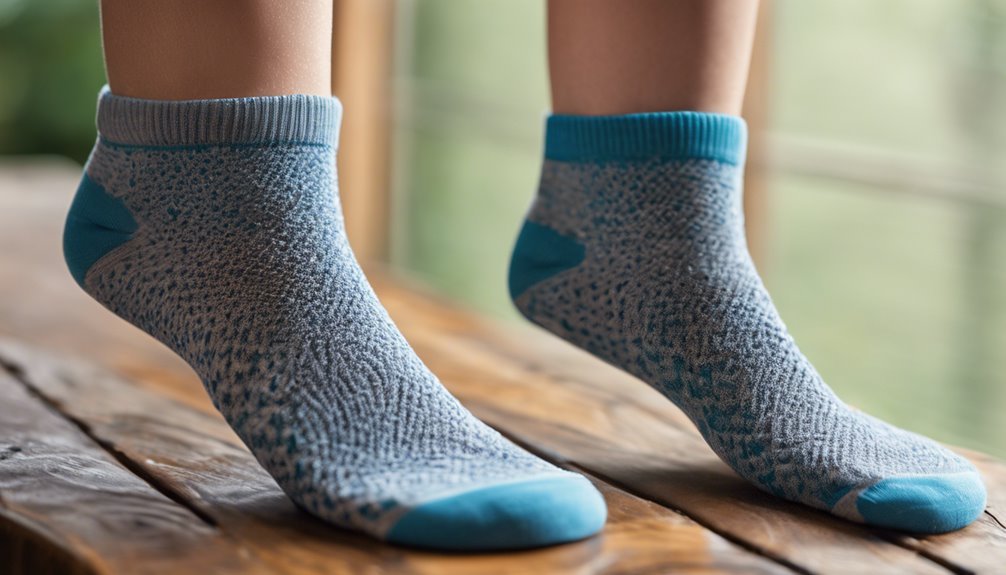
When choosing running socks, understanding moisture management techniques is essential for your comfort. You'll want to take into account fabric composition differences, as certain materials enhance evaporation and breathability. Additionally, socks with antimicrobial properties can help prevent odors and keep your feet feeling fresh during long runs.
Fabric Composition Differences
Understanding the fabric composition of running socks is essential, especially since the right materials can greatly enhance moisture management. The choice of fibers affects not only comfort but also performance. Here are three key aspects to evaluate:
- Synthetic Fibers: Materials like polyester and nylon offer excellent moisture-wicking properties, ensuring your feet stay dry during intense runs.
- Merino Wool: Known for its thermal regulation, merino wool helps keep your feet warm in winter while still managing moisture effectively.
- Blends: Combining different fibers can enhance both fabric durability and moisture control, giving you the best of both worlds.
Choosing the right fabric composition will ultimately lead to a more enjoyable running experience, regardless of the season.
Evaporation and Breathability
How can the right running socks enhance your comfort during a workout? The key lies in sock ventilation and moisture management techniques. Summer running socks typically feature breathable materials that promote evaporation, keeping your feet dry and comfortable. In contrast, winter socks may sacrifice some breathability for insulation, ensuring seasonal comfort.
Here's a quick comparison:
| Feature | Summer Running Socks |
|---|---|
| Ventilation | High |
| Moisture Management | Advanced Evaporation |
| Seasonal Comfort | Optimized for Heat |
Choosing the appropriate socks based on these factors can markedly enhance your running experience, allowing you to focus on your performance without the distraction of discomfort. Stay free, stay comfortable!
Antimicrobial Properties Explained
Why should you care about antimicrobial properties in your running socks? These features can greatly enhance your sock performance by combating odor and bacteria, keeping your feet fresh during those long runs. When you choose socks with antimicrobial benefits, you're investing in comfort and health. Here are three key advantages:
- Odor Control: Antimicrobial treatments prevent the growth of odor-causing bacteria, ensuring your socks stay fresh.
- Skin Health: By minimizing bacteria, you reduce the risk of blisters and skin irritations, allowing for a smoother run.
- Durability: Antimicrobial properties can extend the life of your socks, maintaining their effectiveness over time.
Incorporating these elements into your running gear is essential for a better running experience.
Sock Height and Thickness Considerations
When selecting running socks, the height and thickness are vital factors that can considerably impact your comfort and performance. Sock height varies from no-show to crew length, influencing moisture management and protection from debris. For summer runs, lower sock heights allow for better breathability, while higher socks can provide additional coverage for cooler conditions. Thickness variations also play an important role—thicker socks offer more cushioning but may retain heat, which can be uncomfortable during warmer months. Conversely, thinner socks are lightweight and promote ventilation but may lack cushioning for long distances. Finding the right balance between sock height and thickness guarantees you stay comfortable, allowing you to focus on your run without distractions.
Tips for Choosing the Right Sock for Your Season
Selecting the right running sock for the season can greatly enhance your overall experience, complementing the considerations of height and thickness. To guarantee peak comfort and performance, keep these tips in mind:
- Evaluate Sock Fit: Choose socks that fit snugly without being restrictive; a proper fit helps reduce blisters and enhances breathability.
- Consider Seasonal Factors: For summer, opt for lightweight, moisture-wicking materials that keep your feet dry. In winter, look for thicker, insulating fabrics that retain warmth.
- Check Cushioning Levels: Select cushioning based on your running style and terrain; minimal cushioning suits warm weather, while extra padding is ideal for colder, rougher conditions.
Frequently Asked Questions
Can I Wear Summer Socks in Winter Conditions?
Sure, you could wear summer socks in winter—if you enjoy icy toes! While lightweight materials excel in moisture management, they won't insulate against cold. For comfort, opt for thicker, warmer socks designed for winter conditions.
How Often Should I Replace My Running Socks?
You should replace your running socks every 300-500 miles or when you notice signs of wear, like thinning fabric or loss of elasticity. A shorter sock lifespan can lead to discomfort and blisters during your runs.
Do Sock Colors Affect Heat Retention?
Sock colors can influence heat retention due to color psychology. Darker materials absorb more heat, while lighter ones reflect it. You should consider both sock material and color for ideal temperature regulation during your runs.
Are Compression Socks Suitable for Summer Running?
Compression socks can be suitable for summer running. They offer compression benefits that enhance circulation while their moisture management properties help keep your feet dry, allowing you the freedom to run comfortably even in warmer conditions.
How Do I Wash and Care for My Running Socks?
Caring for your running socks is like nurturing a friendship. Use gentle washing techniques, cold water, and mild detergent. Avoid fabric softeners to preserve sock materials, ensuring your feet feel great mile after mile.

